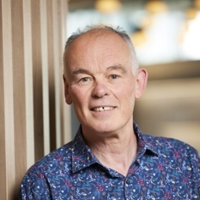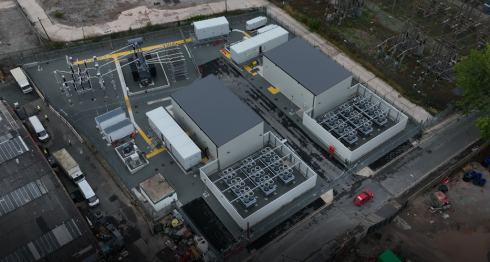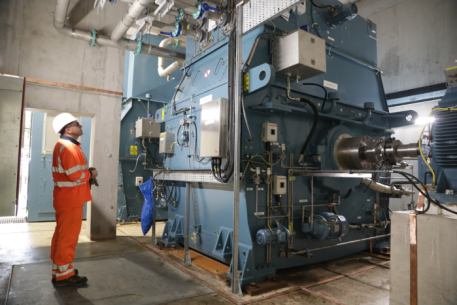Helping the UK power grid spin back its system inertia
Statkraft's Guy Nicholson explains how the way to a more stable UK grid may lie with a new application of an older technology - synchronous compensators

On occasions it has been necessary to shut down wind farms and start up gas power plants. Synchronous compensators promise to maintain stability in the electricity system, without consuming fossil fuels
National Grid Electricity System Operator (NGESO), the operator of the Great Britain electricity system is focused diligently on a target — to be able to operate a zero-carbon electricity grid by Earth Day in 2025. This is sparking a transformation of the British electricity system that is being watched with interest by system operators and manufacturers around the world.
As more renewable energy sources are connected to the electricity system and renewable energy generation increases, new ways to maintain system stability are required. This vital transition from large fossil-fuel plants to renewable energy generation presents a need for innovative solutions that can maintain system stability, increase the amount of renewable energy delivered via the grid network, and reduce costs for consumers.
Inertia is the energy stored in a large rotating mass like a generator or some industrial motors. Historically, the power system relied on the inertia inherent in large, centralized generation plants to keep it stable. Inertia acts rather like a car’s shock absorbers that smooths the shock over bumps in the road.
Inertia provides a response that is temporary and is typically available for only a few seconds. That allows the power grid to ride though short duration faults. This keeps system frequency within controlled limits of around 50 Hz. In an intact, stable system, the frequency of electricity across the power system remains the same and can react to any loss of load or generation due and is robust against disturbances.
Renewable energy generation reduces the impacts of climate change and is essential to NGESO’s goal of operating a zero-carbon electricity grid by 2025. However, the replacement of large fossil-fuelled generation with wind and solar removes much needed inertia that has to be dealt with. In addition to the increasing connection of renewable energy, utilities are also experiencing a growing trend for the large numbers of electric motors in industry and commerce that operate with variable speed drives. While this is an important contribution to energy efficiency, it also results in a further loss of system inertia. These factors have contributed to NGESO reporting an historic and anticipated fall in system inertia.
In its operability strategy report published in December 2022, National Grid said that its current policy was to ensure that system inertia was always above 140 GJ. However, it notes that, by 2025, its ambition is to maintain a minimum system inertia of 96 GJ.
Providing Stability Services
In January 2020, NGESO announced the results for its first Stability Pathfinder approach to managing the stability of the British power grid. Contracts were agreed with five parties (including Statkraft), worth around $400 million over a six-year period, to either build new or modify existing assets to provide the vital stability services. The key service to be provided by Phase 1 is inertia, but without delivering any extra electricity on to the grid. This will, therefore, allow more renewable generation to operate and ensure system stability at lower costs.
In total, the contracts for Phase 1 are procuring 12.5 GJ of inertia. That is equivalent to the inertia provided by about five coal-fired power stations. It was estimated at the time that this approach would save consumers up to $158 million over the six-year period. However, with the surge of gas prices in 2022, it is likely that it will result in much more than this.
As electricity needs are increasingly for energy generated from renewable sources, there will be longer periods where there will be no need for fossil fuel generation and, therefore, additional stability services will be required by projects such as the Lister Drive Greener Grid Park. On April 20, 2020, NGESO had to request generation from 17 gas-fired power plants simply for their stability services, increasing carbon emissions and consumer costs.
Greener Grid Parks
Statkraft is contributing to the Stability Pathfinder initiative through its Greener Grid Parks. One of these is now operational in Moray, Scotland, while the other site that houses two of ABB’s high-inertia synchronous compensators is Lister Drive, in Liverpool, England, became operational in March 2023. Statkraft is progressing several more potential projects across the UK, with consent already given to construct two Greener Grid Parks in the west of Scotland, and one north of Swansea, in Wales.

The Lister Drive Greener Grid Park project provides services including inertia, voltage control and short circuit current, which provide system strength. The site was selected due to its location near to an existing substation that enables the two compensators to connect to the system at the transmission voltage (in this case, 275kV).
Synchronous Compensators
A synchronous compensator is a synchronous machine that is similar in design to a large motor or generator. However, in this context, it is not a motor, as it does not drive anything. Equally, it is not a generator as it does not have a prime mover. However, the compensator draws a small amount of power from the transmission system to supply its inherent losses used keep the compensator rotating.
Fifty years or so ago, synchronous compensators were common in the power industry but in recent years they have become much less common. This is because their former prime function, dynamic reactive power compensation, can be handled by modern power electronics equipment. However, the system stabilization issues discussed are driving the return to rotating devices with physical inertia that replicates the operation of large generating plant.
Synchronous compensators contribute to stable power systems in three main ways:
- Inertia support for frequency stability: There is an increasing level of asynchronous resource being connected to the electricity system. These include interconnectors, wind, solar, tidal and battery energy storage systems (BESS). Compensators have a large rotating mass that provides inertia. They can help by damping frequency deviations, which gives both automatic frequency response plant and manual system operators more time to respond to frequency changes.
- Fault level contribution: In the event of a transmission system fault, asynchronous technologies provide less fault current than synchronous technologies. This is because asynchronous plant with power electronics controls its fault current capability to a level close to the nominal current. However, a synchronous compensator has an innate fault current response defined by its electrical parameters. The result is that the delivered fault current can be high in amplitude, possibly even five times the nominal current or higher.
- Voltage regulation: Like other synchronous and asynchronous technologies, a synchronous compensator can deliver megavolt amperes reactive (MVAr) for voltage regulation. In an under-voltage condition, where the voltage is becoming too low, reactive power is exported to support the system voltage. Equally, in an over-voltage condition, where the voltage is becoming too high, reactive power can be imported.
Capacity and Construction
Typical synchronous compensators have been manufactured with ratings of around 80 MVAr with a 10-20 kV machine voltage. The selected voltage is a matter of optimization as a step-up transformer is often used to suit the usually much higher connection voltage. Several compensator units can be connected to achieve higher outputs. This approach offers better redundancy and system availability than installing a single large unit.
The construction of the ABB - synchronous compensator is quite similar to a synchronous generator. It features a salient pole
rotor, brushless excitation and epoxy resin insulated stator windings. The machine is water-cooled, but other options such as air cooling and hydrogen cooling are also possible.
High-Inertia Solutions
Lister Drive Greener Grid Park is ABB’s first project to feature a high-inertia compensator configuration. This approach couples a 67 MVAr compensator with a 40-ton flywheel.
Combining a mid-size synchronous compensator with a flywheel has the important advantage of multiplying the available inertia by several times. At the same time, the losses may be lower compared to installing the whole inertia as a synchronous compensator. It is also a cost-effective way of using two mid-sized compensators together with the benefits of a high level of redundancy, increased inertia and greater controllability.

Together, the two units at the Lister Drive Greener Grid Park in Liverpool provide a total of more than 900 MW-seconds inertia. That means Lister Drive will provide about 1% of the UK’s projected minimum total inertia requirement for 2025. The compensators were commissioned in March 2023.
To ensure round-the-clock availability for this vital system, Statkraft has signed a 10-year services contract with ABB’s UK field service team to provide a full range of maintenance services, both planned and quick response. Digital condition monitoring solutions will be deployed to optimize performance and predict maintenance needs. By assessing real-time data with cloud-based analysis, the team will be able to plan corrective actions before issues occur, ensuring system reliability.
A Green Solution
Renewable energy continues to make rapid progress in the UK and this success has created some challenges for the power system. On occasions it has been necessary to shut down wind farms and start up gas power plants to keep the system stable. Synchronous compensators promise to maintain stability in the electricity system, without consuming fossil fuels.
Located at strategic points on the grid network, compensators will be able to help prevent power outages, ensure stability and most importantly reduce greenhouse gas emissions from electricity generation with associated cost reductions for consumers.
The UK’s transition to 100% zero carbon electricity and the consequent decommissioning of large synchronous generating plants powered by fossil fuel has resulted in the need for innovative solutions to deliver system inertia vital for system stability. Statkraft’s Greener Grid Park Project in Liverpool is using ABB synchronous compensators that will help to restore this balance.
A version of this article was first published in T&D World.
Contact

Gary Connor
Senior Media Relations Manager, Statkraft UK